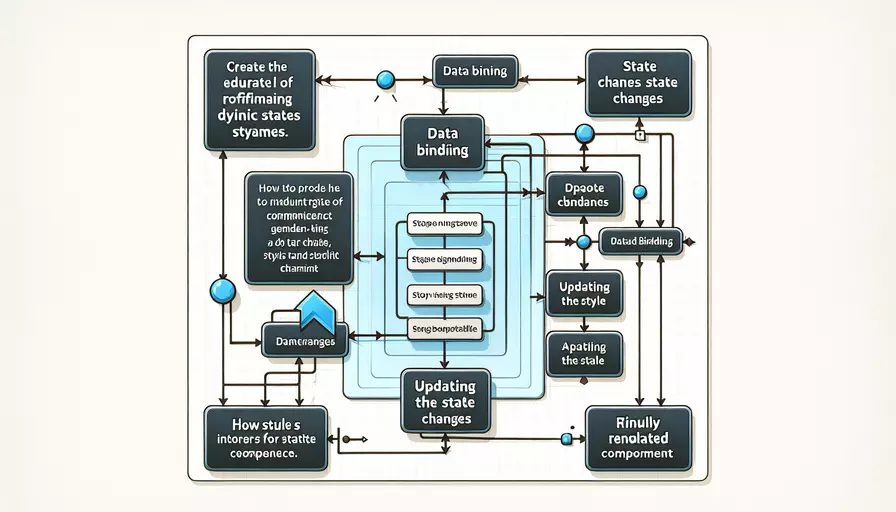
要在Vue中修改动态样式,可以通过以下几种方式:1、使用绑定的style属性;2、使用绑定的class属性;3、使用计算属性。下面将详细介绍这些方法,并说明它们的具体实现和应用场景。
一、使用绑定的style属性
Vue提供了一种简洁的方式,通过绑定style属性来实现动态样式的修改。绑定style属性可以通过对象语法或数组语法来实现。
-
对象语法:通过对象语法,我们可以直接在HTML标签中绑定一个对象,其中每个键值对表示一个CSS属性和值。
<template><div :style="{ color: textColor, fontSize: fontSize + 'px' }">Dynamic Style</div>
</template>
<script>
export default {
data() {
return {
textColor: 'red',
fontSize: 16
};
}
};
</script>
这里,
textColor和fontSize是Vue实例的数据属性,当它们的值发生变化时,绑定的样式也会自动更新。 -
数组语法:通过数组语法,可以绑定多个样式对象,Vue会自动合并这些对象。
<template><div :style="[baseStyles, additionalStyles]">Dynamic Style</div>
</template>
<script>
export default {
data() {
return {
baseStyles: {
color: 'blue',
fontSize: '14px'
},
additionalStyles: {
fontWeight: 'bold',
marginTop: '10px'
}
};
}
};
</script>
在这个例子中,
baseStyles和additionalStyles是两个样式对象,最终应用到div元素上的样式是这两个对象的合并结果。
二、使用绑定的class属性
绑定class属性是另一种常见的实现动态样式的方法。Vue同样支持对象语法和数组语法来绑定class属性。
-
对象语法:使用对象语法,我们可以根据条件来添加或移除某些class。
<template><div :class="{ active: isActive, 'text-primary': isPrimary }">Dynamic Class</div>
</template>
<script>
export default {
data() {
return {
isActive: true,
isPrimary: false
};
}
};
</script>
在这个例子中,当
isActive为true时,active类会被添加到div元素上;当isPrimary为false时,text-primary类不会被添加。 -
数组语法:通过数组语法,可以根据条件添加多个class。
<template><div :class="[isActive ? 'active' : '', isPrimary ? 'text-primary' : '']">Dynamic Class</div>
</template>
<script>
export default {
data() {
return {
isActive: true,
isPrimary: false
};
}
};
</script>
在这个例子中,
active类会被添加到div元素上,而text-primary类不会被添加。
三、使用计算属性
计算属性可以根据其他数据属性来动态计算样式或class,提供了一种更灵活的方式来管理复杂的样式逻辑。
-
计算属性绑定style:通过计算属性,我们可以动态生成一个样式对象,并将其绑定到
style属性上。<template><div :style="dynamicStyles">Dynamic Style with Computed</div>
</template>
<script>
export default {
data() {
return {
baseColor: 'green',
isLarge: true
};
},
computed: {
dynamicStyles() {
return {
color: this.baseColor,
fontSize: this.isLarge ? '20px' : '14px'
};
}
}
};
</script>
在这个例子中,
dynamicStyles计算属性会根据baseColor和isLarge的值来动态生成一个样式对象,并绑定到div元素的style属性上。 -
计算属性绑定class:通过计算属性,我们可以动态生成一个class对象,并将其绑定到
class属性上。<template><div :class="dynamicClasses">Dynamic Class with Computed</div>
</template>
<script>
export default {
data() {
return {
isActive: false,
isPrimary: true
};
},
computed: {
dynamicClasses() {
return {
active: this.isActive,
'text-primary': this.isPrimary
};
}
}
};
</script>
在这个例子中,
dynamicClasses计算属性会根据isActive和isPrimary的值来动态生成一个class对象,并绑定到div元素的class属性上。
总结
在Vue中修改动态样式主要有三种方法:1、使用绑定的style属性;2、使用绑定的class属性;3、使用计算属性。每种方法都有其独特的优势和适用场景。绑定style属性适用于简单的样式修改,而绑定class属性适用于更复杂的条件样式。计算属性提供了一种灵活的方式来处理复杂的样式逻辑。结合使用这些方法,可以实现各种动态样式的需求,使你的Vue应用更加灵活和强大。建议在实际开发中,根据具体需求选择最适合的方法,并充分利用Vue的响应式特性来管理和修改样式。
相关问答FAQs:
Q: Vue中如何修改动态样式?
A: 在Vue中,可以使用绑定样式对象或者绑定样式类来修改动态样式。
- 绑定样式对象: 通过在元素上使用
v-bind:style或者简写形式:style来绑定一个样式对象。在该对象中,键是样式的属性名,值是样式的属性值。
<template>
<div :style="dynamicStyle"></div>
</template>
<script>
export default {
data() {
return {
dynamicStyle: {
backgroundColor: 'red',
color: 'white',
fontSize: '20px'
}
}
}
}
</script>
- 绑定样式类: 通过在元素上使用
v-bind:class或者简写形式:class来绑定一个样式类。在该类中,键是样式类的名称,值是一个布尔值,用于决定是否应用该样式类。
<template>
<div :class="dynamicClass"></div>
</template>
<script>
export default {
data() {
return {
dynamicClass: {
'red-background': true,
'white-text': false
}
}
}
}
</script>
<style>
.red-background {
background-color: red;
}
.white-text {
color: white;
}
</style>
以上两种方法可以结合使用,实现更复杂的动态样式修改。例如,可以根据条件绑定不同的样式对象或样式类。
<template>
<div :style="dynamicStyle" :class="dynamicClass"></div>
</template>
<script>
export default {
data() {
return {
dynamicStyle: {
backgroundColor: this.isRed ? 'red' : 'blue',
color: this.isWhite ? 'white' : 'black',
fontSize: '20px'
},
dynamicClass: {
'red-background': this.isRed,
'blue-background': !this.isRed,
'white-text': this.isWhite,
'black-text': !this.isWhite
}
}
},
computed: {
isRed() {
// 根据某个条件判断是否应用红色样式
},
isWhite() {
// 根据某个条件判断是否应用白色样式
}
}
}
</script>
<style>
.red-background {
background-color: red;
}
.blue-background {
background-color: blue;
}
.white-text {
color: white;
}
.black-text {
color: black;
}
</style>
通过以上方法,你可以根据需要灵活地修改Vue组件的动态样式。
文章标题:vue如何修改动态样式,发布者:不及物动词,转载请注明出处:https://worktile.com/kb/p/3642488

 微信扫一扫
微信扫一扫  支付宝扫一扫
支付宝扫一扫 